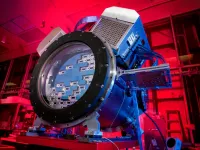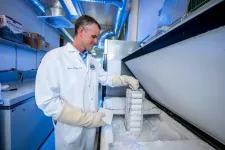(Press-News.org) Paper Title: Predictive Approaches for Acute Dialysis Requirement and Death in COVID-19
Journal: The Clinical Journal of the American Society of Nephrology (published online May 24, 2021)
Authors: Girish Nadkarni, MD, Associate Professor in the Department of Medicine (Nephrology), Clinical Director of the Hasso Plattner Institute for Digital Health, and Co-Chair of the Mount Sinai Clinical Intelligence Center at the Icahn School of Medicine at Mount Sinai; Lili Chan, MD, Assistant Professor in the Department of Medicine (Nephrology) at the Icahn School of Medicine at Mount Sinai; Akhil Vaid, MD, postdoctoral fellow in the Department of Genetics and Genomic Sciences at the Icahn School of Medicine at Mount Sinai, and member of the Mount Sinai Clinical Intelligence Center and the Hasso Plattner Institute for Digital Health at Mount Sinai; and other coauthors.
Bottom Line: SARS-CoV-2, the virus that causes COVID-19, has infected more than 103 million people worldwide. Acute kidney injury (AKI) treated with dialysis was a common complication in patients who were hospitalized with COVID-19. Acute kidney injury is associated with increased risks for morbidity and mortality. Early prediction of which patients will need dialysis or experience critical illness leading to mortality during hospital care can enhance appropriate monitoring, and better inform conversations with patients and their caretakers.
Results: The Mount Sinai team developed and tested five different algorithms to predict patients requiring treatment with dialysis or critical illness leading to death on day 1, 3, 5, and 7 of the hospital stay, using data from the first 12 hours of admission to the Mount Sinai Health System. Out of the five models, the XGBoost without imputation method, outperformed all others with higher precision and recall.
Why the Research Is Interesting: While the Mount Sinai model requires further external review, such machine learning models can potentially be deployed throughout healthcare systems to help determine which COVID-19 patients are most at risk for adverse outcomes of the coronavirus. Early recognition of at-risk patients can enhance closer monitoring of patients and prompt earlier discussions regarding goals of care.
Who: More than 6,000 adults with COVID-19 admitted to five hospitals within the Mount Sinai Health System.
When: COVID-19 patients admitted from March 10 to December 26, 2020.
What: The study uses a machine learning model to determine COVID-19 patients most at risk for treatment requiring dialysis or critical illness leading to death.
How: The team used data on adults hospitalized with COVID-19 throughout the Mount Sinai Health System to develop and validate five models for predicting treatment with dialysis or death at various time periods --1, 3, 5 and 7 days --following hospital admission. Patients admitted to Mount Sinai Hospital in Manhattan were used for internal validation, while the other four hospital locations were part of the external validation cohort. Assessed features included demographics, comorbidities, laboratory results, and vital signs within 12 hour of hospital admission.
The five models created and tested were: the logistic regression, LASSO, random forest, and XGBoost with and without imputation. Out of the total model approaches used, XGBoost without imputation had the highest area under the receiver curve and area under the precision recall curve on internal validation for all time points. This model also had the highest test parameters on external validation across all time windows. Features including red cell distribution width, creatinine, and blood urea nitrogen were major drivers of model prediction.
Study Conclusions: Mount Sinai researchers have developed and validated a machine learning model to identify hospitalized COVID-19 patients at risk of acute kidney injury and death. The XGBoost model without imputation had the best performance compared to standard and other machine learning models. Widespread use of electronic health records makes the deployment of prediction models, such as this one, possible.
Said Mount Sinai's Dr. Girish Nadkarni of the research:
The near universal use of electronic health records has created a tremendous amount of data, which has enabled us to generate prediction models that can directly aid in the care of patients. A version of this model is currently deployed at Mount Sinai Hospital in patients who are admitted with COVID-19.
Said Mount Sinai's Dr. Lili Chan of the research:
As a nephrologist, we were overwhelmed with the increase in patients who had AKI during the initial surge of the COVID-19 pandemic. Prediction models like this enable us to identify, early on in the hospital course, those at risk of severe AKI (those that required dialysis) and death. This information will facilitate clinical care of patients and inform discussions with patients and their families.
Said Mount Sinai's Dr. Akhil Vaid of the research:
Machine learning allows us to discern complex patterns in large amounts of data. For COVID-19 inpatients, this means being able to more easily identify incoming at-risk patients, while pinpointing the underlying factors that are making them better or worse. The underlying algorithm, XGBoost, excels in accuracy, speed, and other under-the-hood features that allow for easier deployment and understanding of model predictions.
INFORMATION:
To request a full copy of the paper or to schedule an interview with the research team, please contact the Mount Sinai Press Office at stacy.anderson@mountsinai.org or 347-346-3390.
Over half of the UK's arts and cultural venues and organisations believe they are at risk due to the decline in income during the pandemic, a new study from the University of Sheffield, University of Kent, and the Chartered Institute of Fundraising has shown.
The only study of its kind, 'Dealing with the crisis: Creativity and resilience of arts and cultural fundraisers during Covid-19' (28 May 2021), gathered information about how arts and cultural fundraisers were impacted by, and managed the Covid-19 pandemic during 2020.
Many artists, organisations and venues rely on fundraising as a significant part of their income, using a range of events and activities to fund creative ...
International research led by Monash University and the Peter Doherty Institute for Infection and Immunity has achieved a proof of concept for a new, fast, portable saliva screening test that uses an infrared light technology to confirm infection with SARS-CoV-2.
The research is published today in Angewandte Chemie.
Professor Bayden Wood, from the Monash University School of Chemistry, Dr Phil Heraud formerly from the Monash Biomedicine Discovery Institute and collaborators Professors Dale Godfrey and Damian Purcell from the Doherty Institute, report on a new diagnostic approach, which involves the use of a portable infrared instrument to detect the SARS-CoV-2 virus ...
On scales too small for our eyes to see, the business of life happens through the making of proteins, which impart to our cells both structure and function. Cellular proteins get their marching orders from genetic instructions encoded in DNA, whose sequences are first copied and made into RNA in a multi-step process called transcription.
A research collaboration at Colorado State University specializes in high-resolution fluorescence microscopy and computational modeling to visualize and describe such stuff-of-life processes in exquisite detail, ...
SAN ANTONIO (May 27, 2021) -- One-fifth of babies who inherit a genetic variant located on chromosome 16 will develop autism spectrum disorder (ASD) by age 3. The variant is called 16p11.2 deletion.
Noboru Hiroi, PhD, of The University of Texas Health Science Center at San Antonio (also referred to as UT Health San Antonio), is studying mice that have this deletion. The team, which includes colleagues from Japan, Ireland and the U.S., is harnessing the power of machine learning to understand which vocalizations of the newborn mouse pups are most predictive of social abnormalities one month ...
Nobody likes driving in a blizzard, including autonomous vehicles. To make self-driving cars safer on snowy roads, engineers look at the problem from the car's point of view.
A major challenge for fully autonomous vehicles is navigating bad weather. Snow especially confounds crucial sensor data that helps a vehicle gauge depth, find obstacles and keep on the correct side of the yellow line, assuming it is visible. Averaging more than 200 inches of snow every winter, Michigan's Keweenaw Peninsula is the perfect place to push autonomous vehicle tech to its limits. In two papers presented at SPIE Defense + Commercial Sensing 2021, researchers from Michigan Technological University discuss solutions for snowy driving scenarios that ...
Ionizing radiation is used for treating nearly half of all cancer patients. Radiotherapy works by damaging the DNA of cancer cells, and cells sustaining so much DNA damage that they cannot sufficiently repair it will soon cease to replicate and die. It's an effective strategy overall, and radiotherapy is a common frontline cancer treatment option. Unfortunately, many cancers have subsets of cells that are able to survive initial radiotherapeutic regimens by developing mechanisms that are able to repair the DNA damage. This often results in resistance to further radiation as cancerous growth recurs. But until recently, little was known about exactly what happens in the genomes of cancer cells following radiotherapy.
To probe the traits of post-radiotherapy cancer ...
May 27, 2021 - Patients undergoing total hip arthroplasty (THA) show significant reduction in pain and other symptoms and improvement in walking gait biomechanics. However, those improvements do not lead to increased daily physical activity levels, reports a study in The Journal of Bone & Joint Surgery. The journal is published in the Lippincott portfolio in partnership with Wolters Kluwer.
The findings "present a worrying picture that while patients have the opportunity to be more physically active through improvements in functional capacity, their physical behaviors do not change," according to the new research, led by Jasvir S. Bahl of the University of South Australia, Adelaide, in collaboration with the University of Adelaide, Flinders University, ...
In 29 new scientific papers, the Dark Energy Survey examines the largest-ever maps of galaxy distribution and shapes, extending more than 7 billion light-years across the Universe. The extraordinarily precise analysis, which includes data from the survey's first three years, contributes to the most powerful test of the current best model of the Universe, the standard cosmological model. However, hints remain from earlier DES data and other experiments that matter in the Universe today is a few percent less clumpy than predicted.
New results from the Dark Energy Survey (DES) use the largest-ever sample ...
LA JOLLA, CA--Even before the COVID-19 pandemic, most people in the United States already had been sick with a coronavirus, albeit a far less dangerous one. That's because at least four coronaviruses in the same general family as SARS-CoV-2 cause the benign yet annoying illness known as the common cold.
In a new study that appears in Nature Communications, scientists from Scripps Research investigated how the immune system's previous exposure to cold-causing coronaviruses impact immune response to COVID-19. In doing so, they discovered one cross-reactive coronavirus antibody that's triggered during a COVID-19 infection.
The findings will help in the pursuit of a vaccine or antibody ...
Although it is not spread through human contact, Francisella tularensis is one of the most infectious pathogenic bacteria known to science--so virulent, in fact, that it is considered a serious potential bioterrorist threat. It is thought that humans can contract respiratory tularemia, or rabbit fever--a rare and deadly disease--by inhaling as few as 10 airborne organisms.
Northern Arizona University professor David Wagner, director of the Pathogen and Microbiome Institute's (PMI) Biodefense and Disease Ecology Center, began a three-year project in 2018 to better understand the life cycle and behavior of F. tularensis, ...



